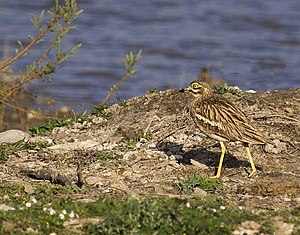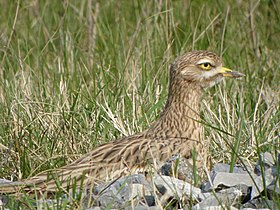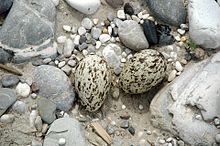Triel
| Triel | ||||||||||
|---|---|---|---|---|---|---|---|---|---|---|

Triel ( Burhinus oedicnemus ) |
||||||||||
| Systematics | ||||||||||
|
||||||||||
| Scientific name | ||||||||||
| Burhinus oedicnemus | ||||||||||
| ( Linnaeus , 1758) |
The triel ( Burhinus oedicnemus ) is one of the nine species of the genus Burhinus , which is the only one of the family of triele (Burhinidae) within the order of the plover-like (Charadriiformes). According to a more recent, not yet generally accepted view, two species are separated from the genus Burhinus and placed in a separate genus Esacus . (see Triele).
The six or so subspecies are distributed from Western Europe and North Africa across the Middle East, southern Central Asia to rear India. In addition to the nominate form, two island races breed in Europe in the Canary Islands and the somewhat lighter and smaller subspecies saharae in southern Spain, the Balearic Islands , some Mediterranean islands and Greece. In Central Europe it is an extremely rare breeding bird and in some countries threatened with extinction.
features

The triel is a compact, long-legged bird; adult animals reach a body length of 38 to 45 centimeters, 76 to 88 centimeters wingspan and weigh between 290 and 535 grams. The basic color of the plumage is sand-colored with dark dotted lines that are particularly noticeable on the neck and chest. The underside of the bird is light, at times almost white. The head is large, as are the eyes with their striking yellow irises. The yellow, massive beak ends in a black tip. Also striking are the strong yellowish legs with clearly thickened heel joints, which have given the species the English name thick-knee . The sexes differ neither in size nor in plumage. The juvenile plumage is also very similar to that of colored birds. There is also no difference between resting and breeding plumage. In flight the species looks very bright from below; if you see it from above, you can see the black hand wings with individual white inclusions. Of all the subspecies, the nominate form is the largest and the darkest in color. Overall, the species is easy to identify and can hardly be confused.
voice
The singing is the most conspicuous indication of the presence of the species. The Reviergesang usually sounds in the evening hours (or at night) and can - with short interruptions - last the whole night. The greatest singing intensity is usually only reached in the early morning hours. It is a melodic, somewhat wistful, relatively high- pitched , not entirely pure flute that can be transcribed with krueeeii or triüüiii . It is performed both on the ground and in flight. The call can be heard almost a kilometer away and is reminiscent of the calls of the curlew . Often several males call at the same time. Melodic plover-like whistles can be heard as further calls. When there is a threat that no longer allows unnoticed escape, adult birds beat their wings on the ground.
Voice examples
Habitat and Distribution
The Triel is an inhabitant of dry, stony areas with little or very little vegetation. In Europe, these are mainly fallow land, coastal dunes, sandy, very light forests, dry grasslands and gravel and gravel banks on river banks. The species is increasingly turning to secondary habitats such as military training areas , gravel pits or abandoned open- cast mining areas . Occasionally, agricultural areas are also settled.
The nominate form breeds from western France and southern England in a broad belt southeast to the Black Sea area and Anatolia, southwest to Spain, south to Sicily, Crete and Cyprus. Most of Germany, Scandinavia including Denmark and the Baltic States were not settled. The species has always been rare in Central Europe and is now only found in very few residual occurrences. In Germany the Triel is currently no longer counted among the regular breeding birds, in Austria there are very small residual occurrences. No exact figures are known about the populations of the other subspecies.
Their distribution areas:
- distinctus : Western Canary Islands
- insularum : Eastern Canary Islands. Both races are lighter colored and less contrasty; they are significantly smaller than the nominate form.
- saharae : The smallest of all subspecies lives in southern Greece, on many Mediterranean islands, in North Africa, Asia Minor, the Middle East as well as in southern Iraq and Iran.
- harteri : The breeding areas of this light-colored subspecies, roughly the size of the nominate form, begin in the southern Volga region and spread loosely over the Caspis , the western Central Asian states , including Afghanistan , Iran and Pakistan to the far north of India.
- indicus : This also small breed inhabits suitable habitats in India and Sri Lanka . Further to the east, the deposits are highly fragmented and extend as far as Korea and Vietnam.
hikes
The triel is both a stationary bird , a partial migrant and a long-distance migrant . The type and extent of migration behavior depend on the subspecies and its breeding location. The Canary Island races, indicus and most populations of saharae are resident birds or short-range migrants. Some stray outside of the breeding season. Most populations of the subspecies harteri migrate in a south and south- westerly direction and overwinter on the edge of oasis areas and in dry steppes on the Arabian Peninsula or in East Africa, in particular South Sudan , Eritrea , Somalia .
The migration behavior of the nominate form is also inconsistent. Almost all continental European populations are migratory birds; some have distinct long-distance migratory traditions. Many English triele (especially young birds from second broods) try to overwinter in the breeding area. The wintering areas of the European migrants already begin in the northern Mediterranean area and in south-west France. In many cases, however, the train continues and can lead to the (especially West African) Sahel zone. Triele are broad-fronted migrants, they fly over the Alps and the Mediterranean, apparently without a bypass strategy. The trans-Saharan migrants choose oasis routes.
From mid-July the continental European triele leave their breeding area and join together to form migrant societies. This first migration leads to suitable areas where the plumage changes. Then (around mid-September) these moulting associations quickly dissolve and the actual migration begins. The southernmost wintering areas are already abandoned towards the end of January, but the central European breeding areas are not reached before mid-March, but mostly in the second or third decade of April.
behavior
Burhinus oedicnemus is crepuscular or nocturnal. Only on very cloudy days and during the rearing of the young were longer periods of activity during the day. Even outside of the breeding season, the start of activity is usually initiated with calls, the greatest intensity of which, however, is only reached shortly before dawn. The species spends the day pressed flat against the ground in good cover. During this rest period, food is only ingested if it is extremely easily accessible. Triele often stand almost immobile for a long time with their posture raised high. Due to their camouflage they are difficult to spot even in this position.
In the event of a malfunction, the triel seldom flies open, but tries to creep or continuously move away from the danger area with crouched body and stretched neck. For the first time, he also runs away from serious threats extremely quickly and with great turns. In front of enemies in the air, he sometimes assumes a high posture , almost reminiscent of a dommel . If it has to be blown up, it never returns directly to the nesting trough, but lands far away; on returning to the clutch, distracting behaviors such as pecking or brooding were observed.
Triele fly with strong and sweeping wing beats, mostly close to the ground and without any special flight maneuvers.
In aggression situations, the posture is upright, the wings are spread out, with the inside of the wing facing the opponent. The bird usually hisses with its beak slightly open. Fighting can occur between conspecifics during the courtship and breeding season, in which the opponents attack each other with their beaks. Chases have also been observed.
Food and subsistence
The diet of the triel is almost exclusively animal; seeds, plants and parts of plants are only consumed to a very small extent. Mainly insects of all kinds, land molluscs , worms as well as spiders and woodlice are preyed on. Small lizards and snakes belong to the range of prey as do young birds and bird eggs as well as various small mammals. The prey animals are searched for on the ground and located both visually and acoustically, often following short stretches of walking or flying after their discovery. Stones are turned over if they are suspected of being prey. The acquisition of food takes place almost exclusively in the twilight hours and at night, only occasionally during the daytime during the breeding season.
Breeding biology

During the mating season and the time of rearing young, triele are territorial, but young birds from first broods and possibly also unmated conspecifics are tolerated in the area. Breeding aid was observed. The Triel probably leads a monogamous seasonal marriage, but there are indications that the pairing already takes place in the winter quarters and the partners go home in pairs. Triele start to breed at the earliest one year, but usually only after the second home migration. During the courtship ritual, the male turns several nesting hollows and indicates them by throwing stones and pseudo-broods. The selection for the final nesting site is made by the female. The courtship rituals are quite diverse. Above all, they consist of various jump dances and mutual bows. The nesting sites are mostly on a subsoil with no or at least little vegetation, often somewhat elevated and near bushes. The clutch consists of two (very rarely three) sand- or clay-colored eggs and is incubated by both parents. Second broods are common, possibly the rule. Brood nesting also often occurs , so that pairs with almost fully fledged and newly hatched cubs have been observed. The parents vigorously defend the clutch. Grazing animals that come too close are driven away by hissing and hissing as well as by air attacks; potential nest robbers, such as ermines , can also be successfully dissuaded from their project in this way. The incubation period is between 25 and 27 days; the young are quite helpless in the first few hours, but can soon be lured away from the nest by their parents. In dangerous situations, they press themselves flat on the ground with their heads stretched out and remain motionless until the adult birds give the all-clear. In such a situation they can even be picked up without any escape reaction occurring . No later than 40 days after hatching, the nest escapees are able to fly. They will continue to be looked after by their parents for around the same time.
Inventory development
In Central Europe, the Triel stocks have collapsed since the middle of the 20th century. Responsible for this development was primarily the destruction of suitable breeding habitats, for example through river regulation, the cultivation of previously fallow wastelands or through road construction. In addition, there are biocides, disturbances in the remaining breeding areas and, to an increasing extent, severe impairment of the survival possibilities in the wintering areas.
In Central Europe there are only small, but reasonably stable populations in Hungary and Alsace . In the Netherlands and Poland it is considered to be extinct, in Germany and the Czech Republic as critically endangered . In the latter states, however, as observations of the breeding season suggest, there may be small residual occurrences of the species. In Austria there is a very small population in Marchfeld and Steinfeld . The population numbers are 2 breeding pairs in Marchfeld and about 7–9 in Steinfeld. They are currently (as of 2019) no longer stable, in Marchfeld the last two breeding pairs are acutely threatened by the construction of the Marchfeld expressway S8. The largest and most stable populations of the species are found in Spain and France with a total of around 50,000 breeding pairs.
The IUCN classifies the species as “least concern” worldwide.
Name derivation
The German name is derived from the reputation of the species, so it is an onomatopoeic name. For the scientific genus name Burhinus derivations are from Greek. Hē būs and Greek. Tò rhinòn so rawhide , or Greek. Hē būs and Greek. Hē rhis conceivable. One would try to describe the coloring of the legs, the other - beef nose - describe the shape of the head. oedicnemus is made up of the Greek verb oidéō (to swell) and the Greek noun hē knēmē (calf), so it roughly corresponds to the English name Thick-knee .
literature
- Urs N. Glutz von Blotzheim (ed.): Handbook of the birds of Central Europe , Volume 7: Charadriiformes (Part 2): snipe, avocet, stilt, triele, racing birds and curlews, common birds . Aula-Verlag, Wiesbaden, 2nd, reviewed edition 1986, ISBN 3-89104-445-3 , pp. 775-801.
- Wolfgang Makatsch : Beach and marsh birds of Europe including North Africa and the Middle East. Gondrom Verlag, Bindlach, 3rd reviewed edition 1986, ISBN 3-8112-0461-0 , pp. 240–242.
- Peter Colston , Philip Burton: Limikolen. All European wader species: identifiers, flight patterns, biology, distribution. BLV-Verlagsgesellschaft, Munich 1986, ISBN 3-405-13647-4 , pp. 30-33.
- Hans-Günther Bauer, Peter Berthold : The breeding birds of Central Europe. Existence and endangerment. Aula-Verlag, Wiesbaden, 2nd revised edition 1997, ISBN 3-89104-613-8 , pp. 166–167.
- Viktor Wember: The names of the birds of Europe. Meaning of the German and scientific names. Aula-Verlag, Wiesbaden 2005, ISBN 3-89104-678-2 .
- Uwe Westphal : Weird birds. Encounters with the bittern, goat milker, hoopoe and other native bird species . pala-Verlag, Darmstadt 2015, ISBN 978-3-89566-342-0 , pp. 86-88.
Web links
- BirdLife International: Birds in Europe (2004) - Population development and status - Burhinus oedicnemus (PDF)
- Distribution map for Europe, good image and name in various European countries ( Memento from January 8, 2006 in the Internet Archive )
- Burhinus oedicnemus in the endangered Red List species the IUCN 2008. Posted by: BirdLife International, 2008. Accessed January 31 of 2009.
- Videos, photos and sound recordings of Burhinus oedicnemus in the Internet Bird Collection
- Age and gender characteristics (PDF; 4.7 MB) by J. Blasco-Zumeta and G.-M. Heinze (eng.)
- Feathers of the Triel
Individual evidence
- ↑ Eurasian Thick-knee - Burhinus oedicnemus. In: www.birdsinbulgaria.org. Birds in Bulgaria, 2011, accessed November 30, 2016 .
- ↑ The last years of the Triel (Burhinus oedicnemus L.) as a breeding bird in Seewinkel (Burgenland) (PDF; 330 kB) from April 1, 2008, accessed on December 27, 2012
- ↑ https://www.derstandard.at/story/2000114931224/der-triel-ein-sehr-seltener-vogel-als-schnellstrassenverhinderer , accessed on February 24, 2020


